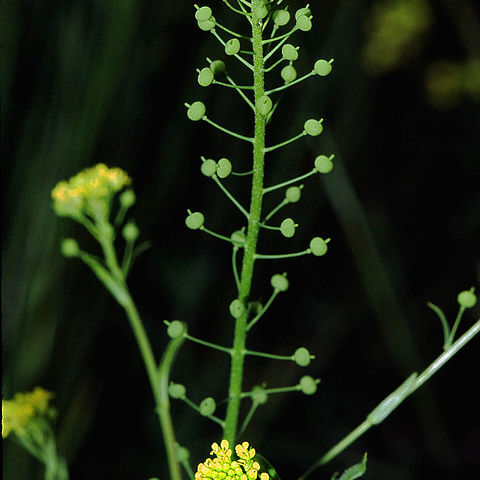Plants sparsely to moderately pubescent, fruits glabrous. Stems (1.4-)2.5-7.5(-9) dm. Basal leaves shortly petiolate; blade oblanceolate to oblong, 2-7.5 cm × 5-20 mm. Cauline leaves: blade lanceolate, narrowly oblong, or linear-lanceolate, (1.5-)2.5-7(-9) cm × (2-) 3-15(-25) mm, apex acute or acuminate, surfaces sparsely pubescent, trichomes mostly forked. Fruiting pedicels straight or slightly curved upwards, (4-)6-10 (-14) mm. Flowers: sepals 1.5-1.7 × 0.5-0.7(-1) mm; petals 2-2.5 × 0.5-0.7(-1) mm; filaments 1.5-2 mm; anthers 0.2-0.4 mm. Fruits (1.7-)2-2.2 × (2-)2.2-2.5 mm; style slender, 0.5-0.9 mm. Seeds 1.2-1.4 × 1-1.1 mm. 2n = 14.
Annual herb, erect, simple or branching, 15–80 cm tall, hairy; hairs stellate. Basal leaves oblong, petiolate, remotely dentate to entire; cauline leaves lanceolate, sessile, sagittate, auriculate, reducing, dentate to entire. Inflorescence an elongated raceme. Sepals 1.5 mm long, erect. Petals 2–3 mm long, yellow. Style filiform, 0.5–1 mm long, constricted near base. Silicula subglobose to compressed, 2–2.5 mm long, 2.5–3 mm wide, indehiscent; valves reticulate-rugose; pedicels spreading, 6–12 mm long. Seeds usually 1 (2 in bilocular silicula), ovoid, 1.5–2 mm long.
Much-branched, to 8 dm, pubescent with branched or 2-pronged hairs; cauline lvs oblong-lanceolate, 3–6 cm, acute, entire or nearly so; fls 1.5 mm wide; mature pedicels slender, divergent, to 1 cm; frs 2 × 2.5 mm; 2n=14. Native of the Near East, found as an occasional weed here and there in our range. June, July.

